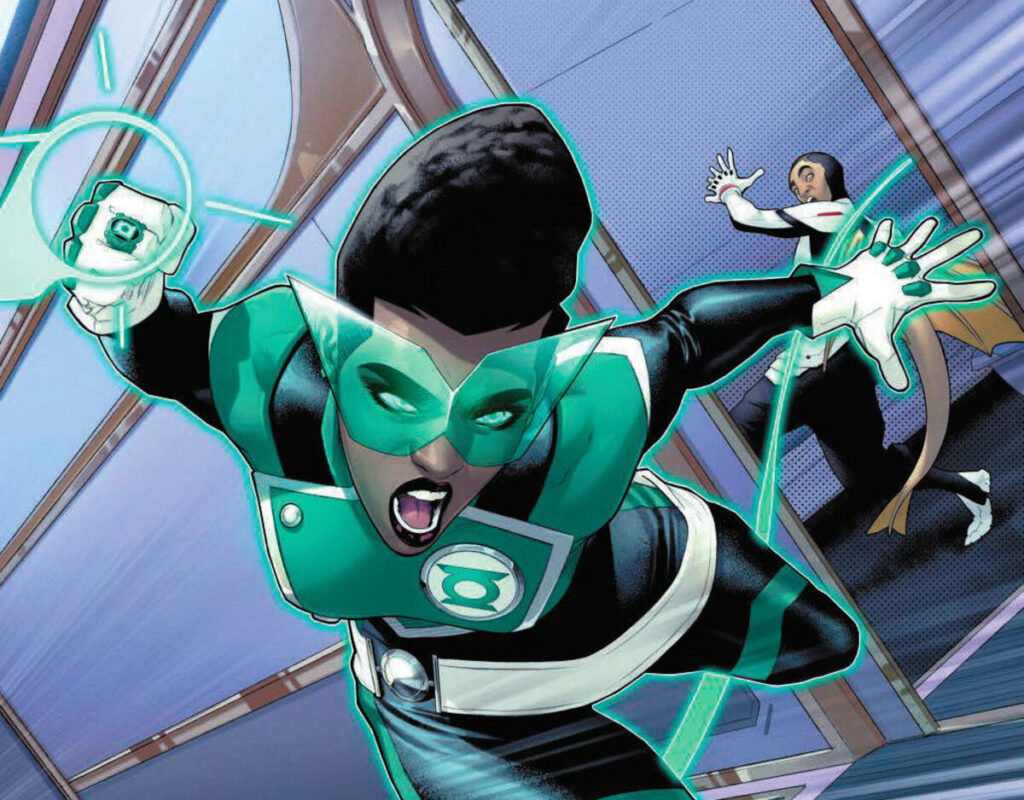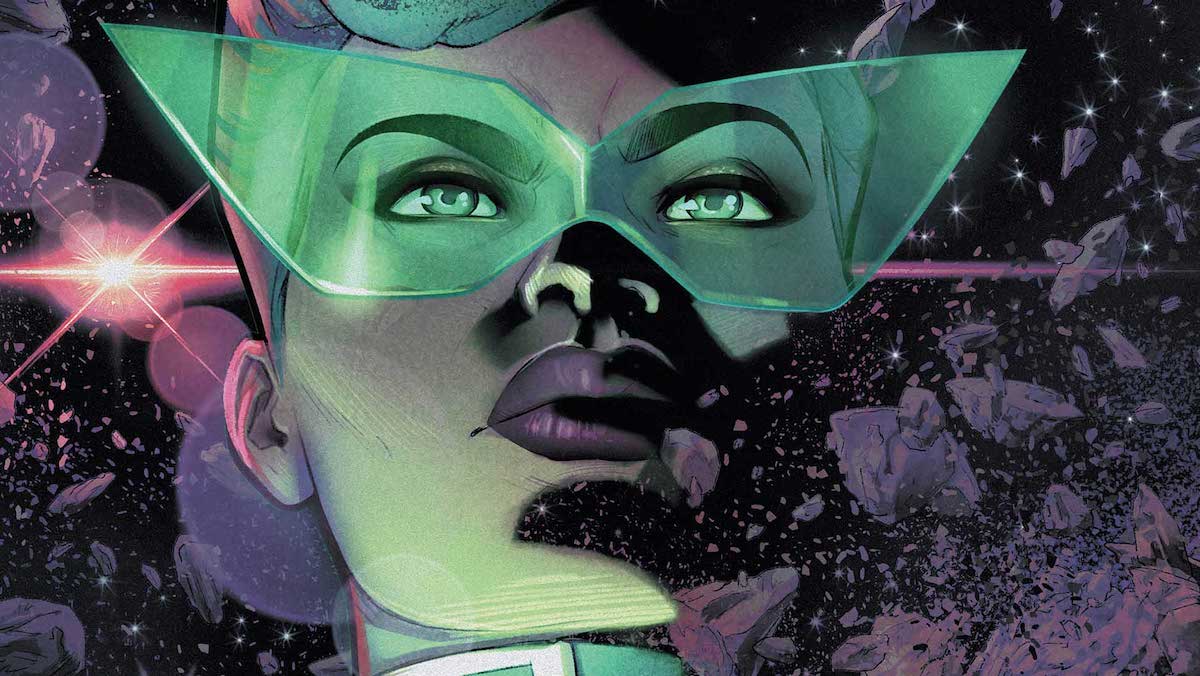Far Sector (Review): When you suddenly have one of the best sci-fi writers of the past five years, NK Jemisin, write a Green Lantern book, ‘Far Sector’ about a lone Green Lantern in a far corner of the universe, farther than even the reaches of the Green Lantern Corps, it piques interest. NK Jemisin, as a science fiction and fantasy author, has always chosen to focus on themes related to cultural and racial conflict and oppression stemming from such conflicts without sounding didactic but utilizing allegorical storytelling. From moments of levity like a strange and fun dance sequence to a giant fist trying to weave through the futuristic police station to some really bright and imaginative visual fighting techniques, Far Sector is a fun and gorgeous-looking book. It deserves to be read in trade and enjoyed by science fiction lovers.
Who is the Green Lantern?

Green Lantern is the name of several DC Superheroes appearing in comic books published by DC Comics. This moniker had been a part of two distinct legacies. In the golden age of comics, The Green Lantern was businessman Alan Scott who wore a magical power ring that created energy constructs. It required charging by a mystical green lantern.
In the silver age, the Green Lantern was reimagined as an intergalactic peacekeeping task force called the Green Lantern Corps. Test pilot Hal Jordan was first selected to be the representative from Earth to serve as the new Green Lantern. Cosmic beings hyperbolically calling themselves “The Guardians of the Universe” living on Planet Oa, which also serves as the headquarters of The Green Lantern Corps, give these lanterns power rings, which run on battery. It requires strong willpower for the Lanterns to create energy constructs and wield those rings. This version of the Green Lantern is the most popular of the lot, to the extent that a 2011 film titled “Green Lantern” was also released, and it followed the exploits of Hal Jordan and how he learns to become a Green Lantern.
However, the Green Lantern has always been a DC property notoriously hard for new readers to crack. The property soon introduced different lanterns into the lore – yellow lanterns that derive their power from the emotion of fear, blue lanterns deriving their power from the emotion of hope, etc. It became a veritable emotional spectrum, exemplified by the different colored rings and the correspondingly colored Lantern Corps.
If you are a fan of continuity and world-building, you will enjoy the Green Lantern stories of the last decade. Fans of writer Grant Morrison will be perplexed at what they were trying to build in their own Green Lantern run. Grant Morrison had always been known to dabble in counter-culture and humanist philosophies within the rigmarole of continuity, but their Green Lantern story had always been a beast of its own.
The Story of Far Sector by NK Jemisin
Jemisin creates a world where Soujourner “Jo” Mullein, an experienced police officer of Earth, is forced to confront a murder in a world where any crime or emotional outburst has been a myth since it got excised for the past five centuries. “The City Enduring” is the rebuilt home of three warring races after they destroyed their two-planet system. To ensure that the rivalry never gets out of hand again, they use a drug called Emotion Exploit (EE) to lessen or completely excise emotional responses.
Jo had been granted an exemption from the EE. Soon after she was assigned, the world experienced its first murder in five centuries. As she dives into investigation, Jo realizes that among the confluence of different races, creeds, and ideologies, the problems she had faced on Earth are multiversal; they continue to apply to a world situated millions of light years away from the galaxy. It is a world where a murder occurs because of trauma and failure to process this trauma. Therefore, an exploration of closure and healthy processing of emotions form one of the key underlying themes of the narrative.
Why “Far Sector” is The Perfect Standalone Science-Fiction Story?
Jemisin does everything possible to make Jo as unique as any of the Green Lanterns we have met. Her ring is different from all the other lanterns; it does not require a powerful battery but takes longer to recharge once it powers down. There are other limitations that get utilized to create conflict in fun and imaginative ways while striving to create a character we can all relate to. Unlike other Green Lanterns, where the ring had been used as a deus-ex machina, the limitations applied to the ring’s power work to keep the story grounded.
The other thing which both Jemisin and Campbell interweave admirably is Jo’s experiences as a black woman to make her understand and empathize with this society she had been tasked to protect. As a result, she has the unenviable job of reckoning with the pros and cons of this emotionless society. There are points during these sequences when the story starts to veer dangerously towards pandering, but Jemisin smartly reels back, letting the characters (more importantly, Jamal Campbell’s visuals) do the talking.
Jamal Campbell’s art is very flowy and yet extremely kinetic. It also helps that Campbell himself colors his art. Thus, the colors perfectly complement the art without smudging or covering them with impressions. There are imaginative opening recap sequences. For example, a white room with a green chair in the middle of the frame, and Jo Mullein enters the room clad in a green business suit, sits on the chair with a posture resembling Morpheus from “The Matrix,” and recaps the events of the last issue, with hints of black humor.
The story is interwoven with philosophical questions on the power of emotions and the suppression of said emotions. For example, the society of the “City Enduring” believe in the suppression of emotions for efficiency, while a sect of regular citizens protests against the suppression of emotions. It dovetails nicely with a commentary on police brutality, considering that Mullein is a part of The Green Lanterns, an intergalactic police task force.
The Character of Soujourner “Jo” Mullein
It’s not easy to create a brand new compelling character in an already established universe, especially an expansive one like the DC universe, but Jemisin and Campbell craft a heroic, flawed, and, yet, principled character easy to root for.
Haunted by her past experience as a black police officer in Detroit, Jemisin wants the readers to empathize with Jo rather than sympathize with her. Her inaction caused a man to end up homeless, and Jemisin makes the character undergo a sense of lament for her own errors. It is also a realistic portrayal of a good cop wanting to contribute to the good of the country, but the systemic rot forces the good cop to take the only way out without compromising on her morals – by stopping to be a cop.
Also, Read- Celluloid Clash: Once Upon a Time in Hollywood’s Book and Screen Adaptation – A Tale of Two Versions
The character of Jo Mullein has been created to be a part of the larger tapestry of the DC Universe, according to the writer NK Jemisin. But there had been many new creations in comic books that hadn’t been utilized by other writers (Mime and Marionette in DC’s Doomsday Clock, Ulysses in Marvel’s Civil War II) until the creators of the characters brought them back into another story. That isn’t the case with Mullein. She is very much a part of the Green Lantern Universe now. Not restricted to the “Far Sector” anymore, she is a key supporting player in Geoffrey Thorne’s Green Lantern saga while also being acknowledged in other key events in the DC Universe landscape.
The character of Jo Mullein has become a breakout star. Thanks to the Far Sector’s unique yet enduring story and the character’s relatability. In a possible future (as seen in the event Future State), Jo Mullein was also the leader of The Justice League. If that isn’t a mark of reaching the big leagues, it would be hard-pressed to find another.
Summing up
A big con of the “Far Sector” is one that most modern superhero stories today face – the dreaded decompression. Modern comics are being written keeping in mind a page count of 128 pages or 336 pages, roughly translating to 6 issues or 12 issues of a single story. As a result, the story is spread out through these issues, slowing down the pacing more than you would expect from a traditional comic book of 28 pages. Far Sector, being read as a monthly release, doesn’t have the same impact, even though the story is designed with cliffhangers bookending each issue.
It is a better read as a trade paperback, with the pacing and character progression enjoyed by readers without any interruption. While it does feel that the overall story could have used a bit of trimming in the middle, it is one of the best comics to come out of DC and definitely one of its most accessible ones.

